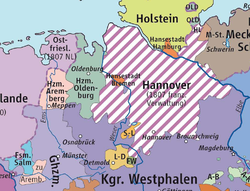County (Duchy) of Arenberg Grafschaft (Herzogtum) Arenberg (German) | |||||||||||||||
|---|---|---|---|---|---|---|---|---|---|---|---|---|---|---|---|
| 1549–1810 | |||||||||||||||
 The Duchy of Arenberg in 1807 after the Napoleonic relocation | |||||||||||||||
| Status | State of the Holy Roman Empire, then State of the Confederation of the Rhine | ||||||||||||||
| Capital | Aremberg | ||||||||||||||
| Common languages | Moselle Franconian | ||||||||||||||
| Government | Principality | ||||||||||||||
| Historical era | Middle Ages Early modern period | ||||||||||||||
• County established | c. 1117 | ||||||||||||||
• Gained Reichsfreiheit | 1549 | ||||||||||||||
• Raised to Princely county | 1576 | ||||||||||||||
• Joined Council of Princes | 1580 | ||||||||||||||
• Raised to Duchy | 1645 | ||||||||||||||
• Joined Confederation of the Rhine | 1806 | ||||||||||||||
| 1810 | |||||||||||||||
| |||||||||||||||
Arenberg, also spelled as Aremberg or Ahremberg, is a former county, principality and finally duchy that was located in what is now Germany. The Dukes of Arenberg remain a prominent Belgian noble family.

